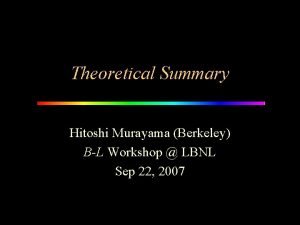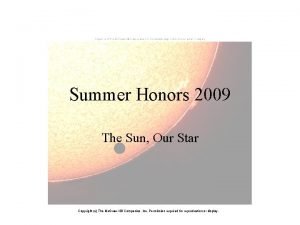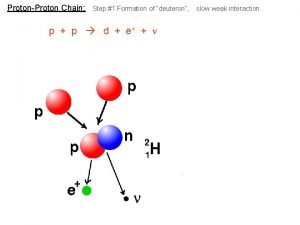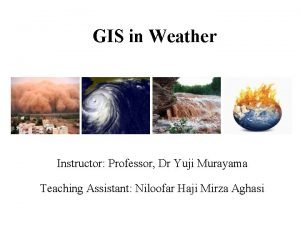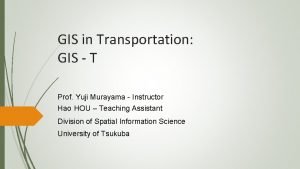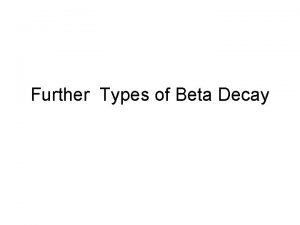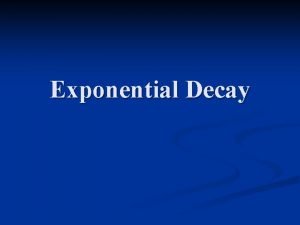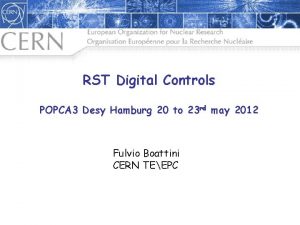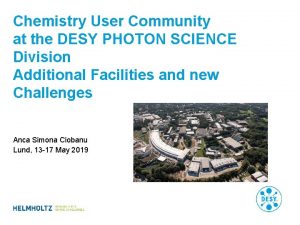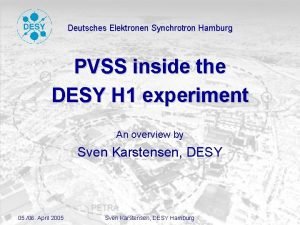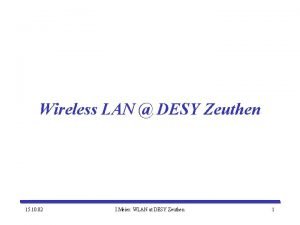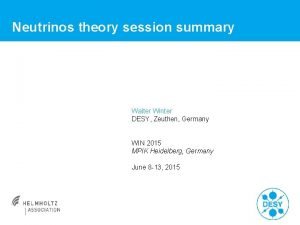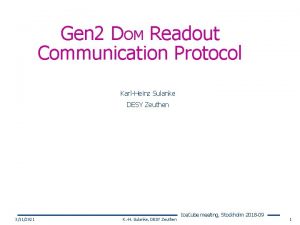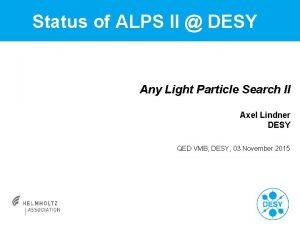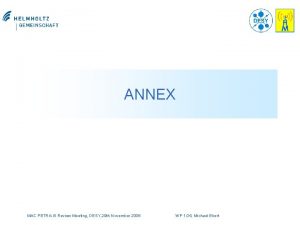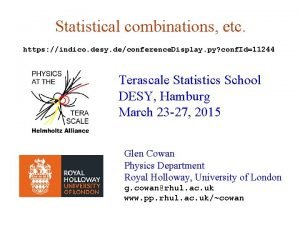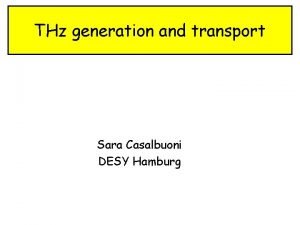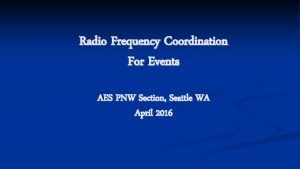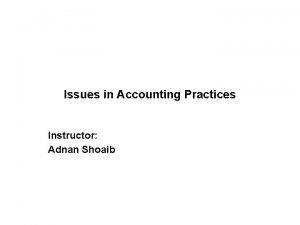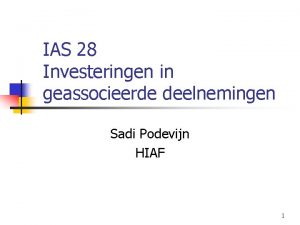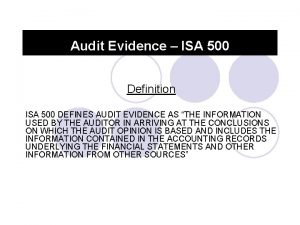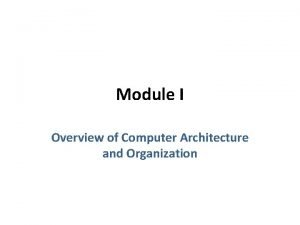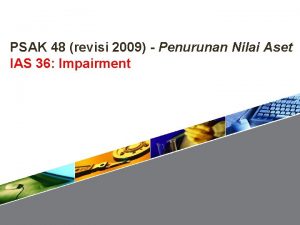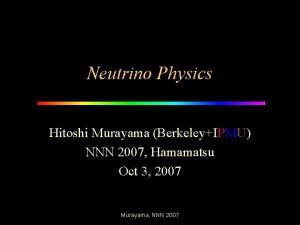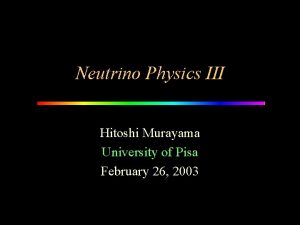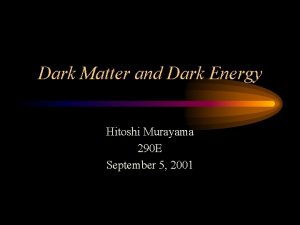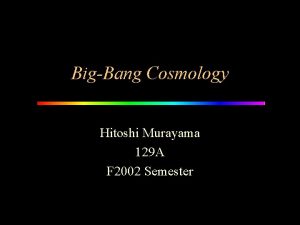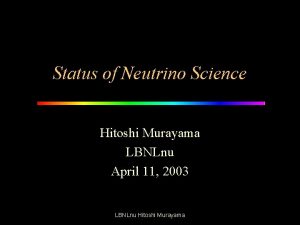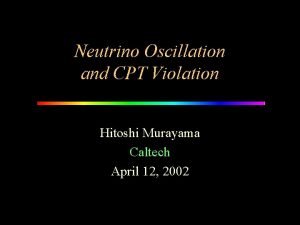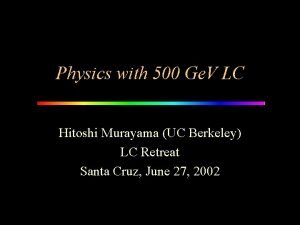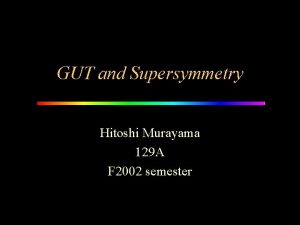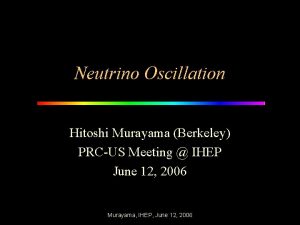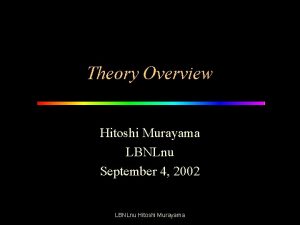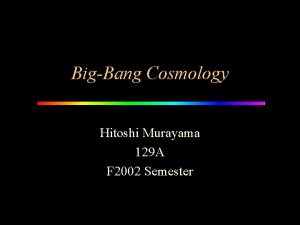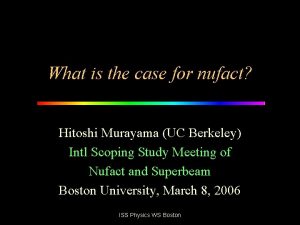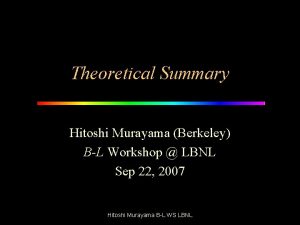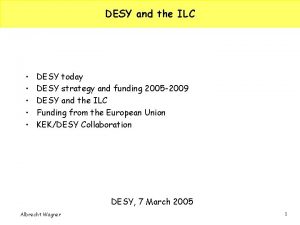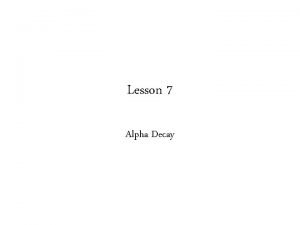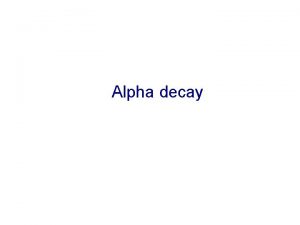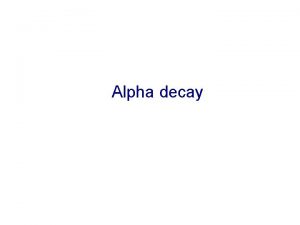Proton Decay in GUTs Hitoshi Murayama IAS DESY


































- Slides: 34

Proton Decay in GUTs Hitoshi Murayama (IAS) DESY Theorie Workshop Sep 24, 2003 Hitoshi Murayama DESY 2003

Outline • • • Brief History of Baryon Number Proton Decay in Grand Unification Proton Decay without Grand Unification B-physics consequence of SUSY-GUT Conclusions Hitoshi Murayama DESY 2003 2

Brief History of Baryon Number Hitoshi Murayama DESY 2003

Problem with Anti-Matter • Anderson discovered positron e+, antimatter of electron in 1932 • A very naïve question: Why doesn’t proton decay p e+g ? • Stückelberg (1939) made up a new conservation law: Baryon number must be conserved (later also by Wigner, 1949) Hitoshi Murayama DESY 2003 4

Lepton Family Number • Similarly ad-hoc conservation law • Neddermeyer-Anderson discovered muon in 1937 • A very naïve question: Why doesn’t muon decay m- e- g ? • Inoue-Sakata made up a new conservation law: Lepton Family number must be conserved • Neutrino oscillations (Super. K & SNO) have disproven lepton family number conservation! Hitoshi Murayama DESY 2003 5

Sacred and secular laws • Sacred conservation laws: consequences of fundamental principles such as gauge invariance, Lorentz invariance, unitarity e. g. , electric charge, CPT, energy-momentum • Secular conservation laws: Happen to be approximately true, but ultimately violated e. g. , parity, CP, lepton family Hitoshi Murayama DESY 2003 6

Fate of Secular Conservation Laws • • Parity Charge Conjugation CP T Lepton Family Lepton Number Baryon Number Fallen 1956 Fallen 1964 Fallen 1999 Fallen 1998 (m), 2002 (e) Still viable (0 nbb? ) Still viable Hitoshi Murayama DESY 2003 7

Maurice Goldhaber’s View (1977) • “Why did these three learned gentlemen, Weyl, Stückelberg, and Wigner, feel so sure that baryons are conserved? Well, you might say that it’s very simple: they felt it in their bones. Had their bones been irradiated by the decays of nucleons, they would have noticed effects considerably exceeding “permissible radiological limits” if the nucleon lifetime were <1016 years and if at least 10% of the nucleon rest mass were to appear as radiation absorbable in the body. That is a fairly sensitive measurement, but one can do much better by a 8 deliberate experiment. ”

Fourth Workshop on GUT (1983) • “Results are presented from the first 80 days of the IMB detector… Limits are set at the 90% CL for the lifetime/branching ratio /B for p e+ 0 at 6. 5 1031 years…” • “That bound appears to rule out minimal SU(5) with a great desert” (Marciano) Hitoshi Murayama DESY 2003 9

Baryon Number as an Accidental Symmetry • In the Standard Model, the proton is absolutely stable • Baryon Number is an “accidental” symmetry, i. e. , there is no renormalizable interaction you can write down that violates the baryon number with the minimal particle content • But once beyond the Standard Model, there is no reason for baryon number to be conserved. • Grand Unified Theories prime example of wellmotivated theories that lead to proton decay • Another example: R-parity violation in SUSY 10

Proton Decay in Grand Unified Theories Hitoshi Murayama DESY 2003

Proton Decay • Quarks and leptons in the same multiplet • Gauge bosons can convert q to l • Cause proton decay via D=6 operators! p e+ 0 • IMB excluded the original SU(5) GUT Hitoshi Murayama DESY 2003 12

Gauge Coupling Unification Hitoshi Murayama DESY 2003 13

Supersymmetric D=5 Proton Decay Exchange of fermionic superpartner of color-triplet SU(5) partner of Higgs boson Suppressed only by the second power of GUT scale vs fourth in X-boson exchange Hitoshi Murayama DESY 2003 14

Supersymmetric D=5 Proton Decay • Effective superpotential W=hchs. MHc– 1 QQQL (Sakai-Yanagida; Weinberg) • Bose symmetry of Q superfields and antisymmetry in color contraction requires that three Q’s to be different flavors • Final state tends to contain strange quark • Depends on MHc • Depends also on superpartner masses • Amplitude ~M 2/msq 2 • Keep M 2 just above LEP limit, msq~1 Te. V Hitoshi Murayama DESY 2003 15

Color-triplet Higgs • Both EW-doublet and color-triplet Higgs in SU(5) 5 and 5* • In Minimal SUSY-SU(5) GUT, doublet is light and triplet is GUT-scale by fine-tuning • W=Hu(l +M)Hd with < >=diag(2, 2, 2, – 3)s≠ 0 and 10– 14 fine-tuning that – 3 ls+M<< s, M • Even soft SUSY breaking fine-tuned (Kawamura, HM, Yamaguchi) • Calling out for solutions. 16

GUT Thresholds • Gauge couplings seems to unify around 2 1016 Ge. V. But how do we know what the MHc is? • A close look at the GUTscale threshold correction allows us to extract MHc from RGE. • Three RGE for three couplings • Unknown parameters at the GUT-scale: a. GUT and three masses MV, MS, MHc • Eliminate a. GUT and two equations left • Fix two combinations: (MV 2 MS)1/3, MHc • Can determine MHc from the couplings @LEP (Hisano, HM, Yangida) Hitoshi Murayama DESY 2003 17

Rest In Peace Minimal SUSY SU(5) GUT • RGE analysis • Super. K limit (p K+n) > 6. 7 1032 years (90% CL) MHc>7. 6 1016 Ge. V • Even if 1 st, 2 nd generation scalars “decoupled”, 3 rd generation contribution (Goto, Nihei) MHc>5. 7 1016 Ge. V (HM, Pierce) Hitoshi Murayama DESY 2003 18

It doesn’t rule out SUSY-GUT • Unfortunately, the prediction of the proton decay via D=5 operator is sensitive to the ugliest aspect of the SUSY-GUTs – Triplet-doublet splitting – Fermion mass relation ml=md • Any “solution” to these big problems is likely to modify the proton decay prediction. Hitoshi Murayama DESY 2003 19

Triplet-Doublet Splitting Flipped SU(5) • Flipped SU(5) – Ellis et al – Not quite a unification SU(5) U(1) – Broken by 10– 1 (not 24) – Triplet massive by W= 10– 1 H – No triplet-doublet splitting problem – Eliminates D=5 operator completely – MGUT where SU(3) and SU(2) meet is ~1015 Ge. V – D=6 can be important • Super. K: (p e+ 0)>1. 6 1033 year (90% CL, 25. 5 kt year) • Minimal SUSY GUT: (p e+ 0)=8 1034 year (MV/1016 Ge. V)4 MV>1. 4 1016 Ge. V • Flipped SU(5): (p e+ 0)=4 1035 year (MV/1016 Ge. V)4 MV>2. 6 1015 Ge. V Hitoshi Murayama DESY 2003 (HM, Pierce) 20

Triplet-Doublet Splitting Orbifold GUT Breaking • (Kawamura; Hall, Nomura) • SU(5) SU(3) SU(2) U(1) normally achieved by < (adjoint)>≠ 0 • New way to break SU(5) by boundary conditions on extra line segment S 1/Z 2 • Boundary conditions explicitly break SU(5) • Still unitarity OK • No D=5 operator • Compactification scale (Hall, HM, Nomura) Mc~1015 Ge. V • Natural triplet-doublet splitting • Can have new D=6 • Gauge coupling unification operators on the fixed improved point ~1/Mc 2 Hitoshi Murayama DESY 2003 21

p e+ 0 • Super. K: (p e+ 0)>1. 6 1033 year (90% CL, 25. 5 kt year) • Minimal SUSY GUT: (p e+ 0)=8 1034 year (MV/1016 Ge. V)4 MV>1. 4 1016 Ge. V • Flipped SU(5): (p e+ 0)=4 1035 year (MV/1016 Ge. V)4 MV>2. 6 1015 Ge. V • 5 -D orbifold GUT: (p e+ 0) 1034 year May well be just around the corner 22

Fermion Mass Relation Georgi-Jarlskog • Georgi-Jarskog relation – me~md/3 – mm~ms*3 • Can be achieved using Higgs in 45* rather than 5* • Different Clebsch-Gordan factors • D=5 operator worse by a factor of two Hitoshi Murayama DESY 2003 2 2 23

Threshold Corrections • Add an otherwise unmotivated additional 5+5* • Split them using < > in the opposite way from Higgs: – Triplet lighter – Doublet heavier • Changes the threshold correction and allows MHc raised (HM, Pierce) • SO(10) models have many more fields at the GUTscale • Typically worse than SU(5) • But larger possible range in threshold correction • Allows MHc raised somewhat • Just above the current limit (p K+n)<1034 yrs (Babu, Pati, Wilczek) Hitoshi Murayama DESY 2003 24

Proton Decay Without GUT Hitoshi Murayama DESY 2003

Planck-scale D=5 operators • D=5 operators in SUSY suppressed by only one power of the high scale • Even Planck-scale operator bad • W=l MPl– 1 QQQL • Requires l ~10– 7 • “Generic” string compactification excluded • Need suppression Hitoshi Murayama DESY 2003 26

Planck-scale D=5 operators • W=l MPl– 1 QQQL requires l ~10– 7 • Flavor symmetry suppressed Yukawa couplings • Same suppression appears for other flavor operators • Likely suppression by powers of Yukawa couplings, e. g. , ~hshc • Typically “intersting size” (HM, Kaplan) Hitoshi Murayama DESY 2003 27

R-parity Violation • R-parity = (– 1)3 B+L+2 S • Forbids baryon and lepton number violation W=udd+Qd. L+LLe+LHu • If it exists: p~msq 4/mp 5~10– 12 sec! • Product of two couplings < 10– 26 • If GUT, 10 5* 5* contains both udd & Qd. L Hitoshi Murayama DESY 2003 28

B-physics Consequence of SUSY-GUTs Hitoshi Murayama DESY 2003

Large q 23 and quarks • Large mixing between n and nm • Make it SU(5) GUT • Then a large mixing between s. R and b. R • Mixing among righthanded fields drop out from CKM matrix • But mixing among superpartners physical • O(1) effects on b s transition possible (Chang, Masiero, HM) • Expect CP violation in neutrino sector especially if leptogenesis Hitoshi Murayama DESY 2003 30

Consequences in B physics • CP violation in Bs mixing (Bs J/y f) • Addt’l CP violation in penguin b s (Bd f Ks) Very reasonable place for new physics to show up! Hitoshi Murayama DESY 2003 31

Murayama DESY 2003 Harnik, Larson, HM, Hitoshi Pierce 32

Conclusions • Baryon/lepton numbers very likely violated • Neutrino mass and proton decay: window to extreme high-energy physics even up to Planck scale • Current limits on proton decay had already excluded the original GUT and the Minimal SUSY GUT • Many modifications of GUT predict proton decay within the reach of next generation (~1 Mt) experiments Hitoshi Murayama DESY 2003 33

Future will be painful Because we will most likely find proton decay And we’ll feel it in our bones. Hitoshi Murayama DESY 2003
 Hitoshi murayama
Hitoshi murayama Proton proton chain
Proton proton chain Nuclear fission
Nuclear fission Proton proton chain
Proton proton chain Yuji murayama
Yuji murayama Yuji murayama
Yuji murayama Remains by simon armitage analysis
Remains by simon armitage analysis Poem remains
Poem remains Beta decay equation
Beta decay equation Decay factor and decay rate
Decay factor and decay rate Popca
Popca Desy photon science
Desy photon science Quelle
Quelle Desy summer student
Desy summer student Desy wap
Desy wap Desy wifi
Desy wifi Walter winter desy
Walter winter desy Desy sax
Desy sax Desy summer student
Desy summer student Alps desy
Alps desy Bf desy
Bf desy Desy hostel
Desy hostel Michael ebert desy
Michael ebert desy Indico desy
Indico desy Sara casalbuoni
Sara casalbuoni Ias frequency coordination
Ias frequency coordination Adnan shoaib
Adnan shoaib International accounting standards ias
International accounting standards ias Ias 28
Ias 28 Isa 500 audit evidence
Isa 500 audit evidence Ias computer architecture
Ias computer architecture Investment property ias 40
Investment property ias 40 Ias 27
Ias 27 Ashutosh pednekar
Ashutosh pednekar Ias 2009
Ias 2009
